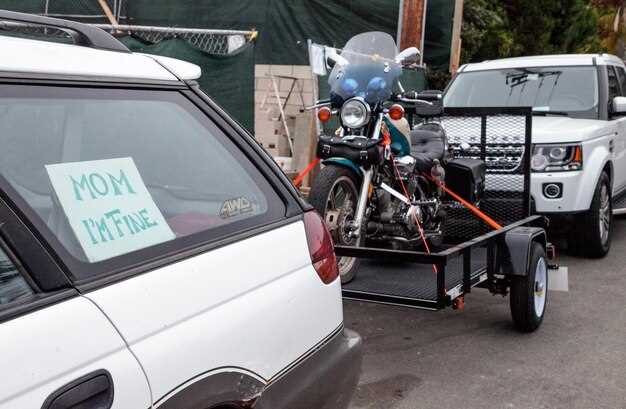
Determining the optimal towing speed for motorcycle trailers is crucial for ensuring safety and efficiency while on the highway. The interaction between the trailer and the towing motorcycle is significantly affected by speed, which can impact stability, fuel efficiency, and overall handling. Understanding these dynamics is essential for both novice and experienced riders who seek to transport their motorcycles effectively.
The highway conditions and specific regulations regarding towing speeds vary by state and country. Generally, it’s advisable to maintain a speed that balances the need for maintaining control with the legal speed limits imposed on highways. Going too fast can increase the risk of losing control, while driving too slowly can create hazards for other drivers. Striking the right balance is key to a smooth towing experience.
Moreover, the weight of the trailer and the motorcycle being towed plays a considerable role in determining what the optimal speed should be. Heavier loads may require slower speeds to maintain stability, particularly when navigating windy or uneven road conditions. An understanding of your specific setup is necessary to optimize performance while ensuring safety on the highway.
Understanding Safe Speed Limits for Towing on Highways

When towing a motorcycle trailer on highways, it is crucial to adhere to established speed limits to ensure safety for you and other road users. Speed limits vary by state and region, but there are general principles that govern safe towing practices. Always check local regulations, as they may impose stricter limits specifically for towing situations.
One of the primary factors affecting safe towing speeds is the trailer’s weight. Heavier loads require increased stopping distances and may cause instability, particularly at higher speeds. It is advisable to maintain a speed that allows for comfortable handling and adequate reaction time in emergency situations.
Typically, towing speed limits on highways are lower than standard speed limits for vehicles without trailers. This is often due to the fact that trailers decrease maneuverability and increase the risk of sway. Many jurisdictions suggest or enforce a maximum towing speed of 55 to 60 miles per hour. However, conditions such as traffic, weather, and road surface should also influence your chosen speed.
Drivers should also consider the effects of wind and other environmental factors that can impact stability while towing. Crosswinds can push a trailer sideways, so slowing down during windy conditions can enhance safety and control. Additionally, it is essential to maintain an adequate following distance from other vehicles, as the increased weight and length of a towing setup can result in longer stopping distances.
Understanding and respecting safe speed limits for towing on highways is essential for a successful and secure journey. Always prioritize safety over speed by adjusting your driving based on the vehicle’s handling characteristics and external conditions.
How Towing Speed Affects Stability and Handling of Motorcycle Trailers
Towing speed plays a crucial role in the stability and handling of motorcycle trailers. When traveling on the highway, the dynamics between the motorcycle and the trailer change significantly as speed increases. At lower speeds, the center of gravity tends to remain stable, allowing for easier maneuverability. However, as the towing speed elevates, the forces acting on the trailer can lead to swaying or fishtailing.
Higher speeds increase the wind resistance and aerodynamic pressure on the trailer, which can cause instability. If the motorcycle and trailer are not properly matched in weight and design, the risk of losing control becomes more pronounced. It is essential to maintain a balanced towing speed to ensure that both the motorcycle and trailer handle predictably and safely.
Moreover, towing at excessive speeds can cause tires to overheat, potentially leading to blowouts. This scenario can create dangerous situations, especially on busy highways. Therefore, keeping towing speeds within recommended limits is vital not only for safety but also for optimal handling and stability during transit.
Adjusting towing speed based on road conditions, weather, and trailer load is essential. Riders should practice defensive driving techniques, particularly at higher speeds, and should be aware of how their specific setup reacts to various speeds. Doing so helps assure a safer and more stable towing experience on the highway.
Factors Influencing Towing Speed: Weight, Weather, and Road Conditions

When considering optimal towing speeds for motorcycle trailers, several key factors play a critical role: weight, weather, and road conditions. Each of these elements can significantly affect the overall towing experience and safety on the highway.
The weight of the trailer and its contents is paramount. Heavier loads require more power from the motorcycle, which can reduce acceleration and affect braking distance. This may necessitate lower towing speeds to maintain control and stability, especially during highway travel. It’s essential to stay within the recommended weight limits for both the motorcycle and the trailer to ensure safe performance.
Weather conditions also have a substantial impact. Rain, snow, and strong winds can greatly reduce traction, making higher speeds more dangerous. On wet or icy roads, towing at a slower speed can improve handling and reduce the risk of skidding. Additionally, high winds can cause turbulence that affects stability, making it advisable to adjust towing speeds accordingly.
Road conditions cannot be overlooked when determining towing speed. Poorly maintained or uneven roads can lead to increased difficulties in handling a trailer. Uneven surfaces can cause swaying, which may require reducing speed on the highway to avoid losing control. Furthermore, sharp curves and steep grades demand careful speed management to ensure safe maneuvering while towing.
In summary, the ideal towing speed is influenced by the combined effects of weight, weather, and road conditions. Motorcyclists must assess these factors and adjust their speeds accordingly to maximize safety and performance while towing on the highway.





